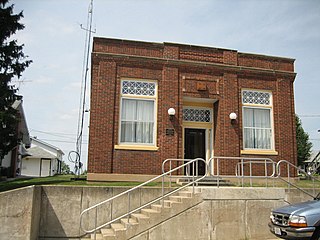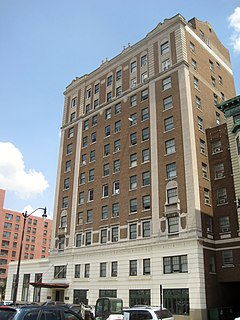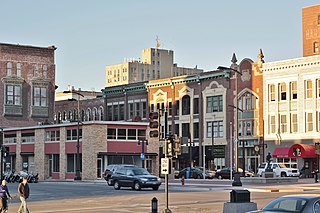
McDonough County is a county in the U.S. state of Illinois. According to the 2010 census, it had a population of 32,612. Its county seat is Macomb.

Orangeville is a village in Stephenson County, Illinois. The population was 793 at the 2010 census, up from 751 in 2000. The area's earliest white settlers arrived in the year 1833, and the village was platted in 1851 by John Bower, who is considered the village founder. In 1867 Orangeville was incorporated as a village. The town's central business district contains several 19th century commercial buildings, many of which were built during the railroad boom of 1888–1914. By the time the Great Depression was ongoing, business in Orangeville had started to decline, with the last bank closing in 1932. Although recently infrastructure jumps have given back some of its old decor.

White River Junction is an unincorporated village and census-designated place (CDP) in the town of Hartford in Windsor County, Vermont, United States. The population was 2,286 at the 2010 census, making it the largest community within the town of Hartford.

The France Hotel is a historic hotel located at 118 E. Court St. in Paris, Illinois. The Classical Revival building was constructed in 1924. It is listed on the National Register of Historic Places.

Sherman Hall is the main administrative building of Western Illinois University and site of the original Western Illinois State Normal School in Macomb, Illinois.

Plano, also known as the Chicago, Burlington and Quincy Railroad Depot is an Amtrak intercity train station in Plano, Illinois, United States. The station was added to the U.S. National Register of Historic Places on November 12, 1993.

Pullman National Monument, also known as The Pullman District and Pullman Historic District, is located in Chicago and was the first model, planned industrial community in the United States. The district is significant for its historical origins in the Pullman Company, one of the most famous company towns in the United States, and scene of the violent 1894 Pullman strike. It was built for George Pullman as a place to produce the famous Pullman sleeping cars.

The People's State Bank building is located in the Stephenson County village of Orangeville, Illinois, United States. The structure was erected in 1926 when two Orangeville banks merged to form the People's State Bank. It operated until 1932 when it became overwhelmed by an economic disaster caused by the Great Depression and the bypassing of downtown Orangeville by an important route. The building is cast in the Commercial style and features Classical Revival detailing, common for banks of the time period. The building was added to the U.S. National Register of Historic Places in 2004.

The Belvidere U.S. Post Office is a historic building located in the Illinois city's downtown business district. It was built in 1911 and represents a good example of Classical Revival architecture. It was added to the National Register of Historic Places as United States Post Office-Belvidere in 2000.

There are nine historic districts in Meridian, Mississippi. Each of these districts is listed on the National Register of Historic Places. One district, Meridian Downtown Historic District, is a combination of two older districts, Meridian Urban Center Historic District and Union Station Historic District. Many architectural styles are present in the districts, most from the late 19th century and early 20th century, including Queen Anne, Colonial Revival, Italianate, Art Deco, Late Victorian, and Bungalow.

The Conyers Residential Historic District is an irregularly-shaped historic district in Conyers, Georgia, the only city in Rockdale County, Georgia, located 24 miles east of Atlanta. The district's development dates from the 1840s.

The Graves Hotel is a historic hotel located at 106 South Central Avenue in Harlowton, Montana. A. C. Graves, a leading figure in Harlowton's early development, had the hotel built in 1909; it was one of the first businesses to be built after a fire destroyed much of downtown Harlowton in 1907. The hotel was the first sandstone building in Harlowton, though the stone eventually became a common building material; its design features a projecting corner oriel window topped by a metal cupola. In addition to hosting visitors and railroad travelers, the hotel also served as a community meeting place and business center.

The St. Nicholas Hotel is a historic hotel building located at 400 E. Jefferson St. in Springfield, Illinois, US.

The Broadview Hotel is a historic hotel building located at 415 E. Broadway in East St. Louis, Illinois. The Classical Revival hotel was constructed in 1927. From its opening until the 1950s, the hotel was one of the finest in East St. Louis. It was added to the National Register of Historic Places in 2013.

The Siloam Springs Downtown Historic District encompasses the historic downtown area of Siloam Springs, Arkansas. The district is roughly bounded by University Street, Broadway, and Sager Creek, with a few buildings on adjacent streets outside this triangular area. This business district was developed mainly between about 1896, when the railroad arrived, and 1940, and contains a significant number of buildings dating to that period. It also includes Siloam Springs City Park, the location of the springs that gave the city its name. Notable buildings include the First National Bank building, a c. 1890 Romanesque Revival building, and the c. 1881 Lakeside Hotel, which is one of the city's oldest commercial buildings.

The Decatur station, also known as the Wabash Railroad Station and Railway Express Agency, is a historic railway station located at 780 East Cerro Gordo Street in Decatur, Illinois. Built in 1901, the station served trains on the Wabash Railroad, the most economically significant railroad through Decatur. Architect Theodore Link designed the Classical Revival building. Service to the station ended in the 1980s, and it has since been listed on the National Register of Historic Places.

The Decatur Downtown Historic District is a historic commercial district located in downtown Decatur, Illinois. The district includes 75 buildings, 61 of which are considered significant or contributing to its historic character. While downtown Decatur was platted in 1829, it did not experience significant commercial development until 1854, when two railroads built lines through the city; all but one of the district's contributing buildings were built between 1854 and 1916. The district includes many of the commercial buildings which were built in the economic boom following the railroad's construction. These buildings represent several popular commercial architectural styles of the period, including Classical Revival, Italianate, Romanesque, and Chicago School. The district also includes several sites connected to Abraham Lincoln's legal and political career.

Shore Acres is a historic former summer hotel at 791 Lamoine Beach Road in Lamoine, Maine. With a possible construction history dating to about 1800, it is one of the coastal community's oldest buildings, and is the only surviving 19th-century hostelry in the town. Extensively altered in 1887 and operated as an inn between 1887 and 1942 as the Des Isles Inn, it is now a summer rental property, located within walking distance of Lamoine Beach State Park. The property was listed on the National Register of Historic Places in 2000.

The Old Post Office, also known as the former Pekin Federal Building, is a historic building in Pekin, Illinois. Built in 1906, the building held Pekin's U.S. government offices; the first floor served as the city's main post office, while the second floor held various offices, including a Department of the Treasury office and an Army recruitment office. Supervising Architect James Knox Taylor designed the building in the Renaissance Revival style, in keeping with the tradition of using classical styles for federal buildings. The building's design features a red brick exterior with a limestone base and quoins; fanlights and keystones above the first-floor windows; and a limestone cornice with a parapet wall and a cartouche above the main entrance.

























